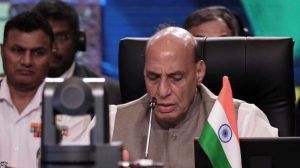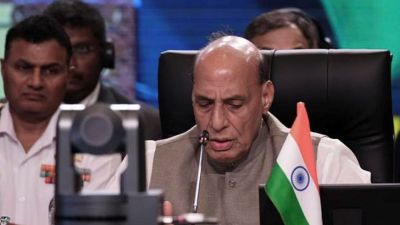Govt’s power policy, no subsidy: Why area under shrimp farming is decreasing in Punjab
Farmers want to diversify crops for profits but no incentive for aquaculture pushing them to the brink
 Rupinderpal Singh Dhillon at his shrimp farming pond.
Rupinderpal Singh Dhillon at his shrimp farming pond.Saroop Singh Sandhu, 40, started shrimp farming in 2017 on 2.5 acres of his total 15-acre land in Ratta Tibba village in Muktsar Sahib. He had tried fish farming in 2012 but was unsuccessful. Shrimp farming, however, proved more lucrative, bringing in profits of Rs 1.5 to Rs 2 lakh per acre. Encouraged, he Saroop expanded his shrimp farm to 35 acres. All was going well till 2021 but in 2022, the government changed its power policy for shrimp farmers and started charging Rs 7 per unit. He has now reduced his shrimp farming to just 15 acres.
Gurpayar Singh, 37, a marginal farmer from Bhangala village in Fazilka, met a similar fate. Hoping to profit from his otherwise unproductive saline land, he started shrimp farming on two acres a few years ago but faced around Rs 9 lakh loses when the shrimps died due to disconnection of power supply to the ponds. “I have now taken 5 acres on lease to grow cotton and to make ends meet,” he said, adding that shirmp farming was a lucrative venture for marginal farmers like him but he could not continued due to government’s policy.
Rupinderpal Singh Dhillon (35) of Jandwala Chrat Singh village in Muktsar Sahib also scaled down his shrimp farming from 35 acres to 25 acres. He had started the farming on 1.5 acres in 2017.

These farmers and many more like them had hoped to revitalise their unproductive lands with this alternative farming practice. But are now being forced to either bring down operations or abandon the business altogether. They said shrimp farming is a promising venture for Punjab’s farmers who are dealing with high amount of saline water in their farm lands but high electricity bills and hefty fines are forcing them to the reduce area now.
Saroop Singh, who is also the president of Shrimp Farmer Association Punjab, said that in 2017, when shrimp farming started in the state, farmers had started increasing the area under the crop manifold. Till last year the area under it was 1200 acres but now it has reduced to nearly half.
“Earlier our power connections were treated under Agriculutral Pump (AP) policy of the government under which all farmers of the state are covered and were getting free power for agriculture. But from 2022, our connections are treated under the industrial tariff category and we are charged Rs 7 per unit, which is very high compared to states such as Andhra Pradesh, where such farmers pay at the rate of Rs 1.50 per unit,” Saroop said, adding that farmers who grow paddy get power subsidy but others who are diversifying are getting hefty bills.
“The government can either include us under the AP category or can make some other viable arrangement so that this burden on farmers can be mitigated to a large extent. We pay around Rs 70,000 to Rs 1 lakh per acre power bill in a season apart from heavy fines,” Saroop said, adding that profits have now reduced to Rs 50,000 per acre or nothing against Rs 1.5 to Rs 2 lakh earlier.
Gurpayar Singh said that he was fined Rs 9 lakh, and his electricity connection was cut off, causing his shrimps, worth around Rs 8 lakh, to die in the pond last year.
 Saroop Singh Sandhu shows a procedure of shrimp farming.
Saroop Singh Sandhu shows a procedure of shrimp farming.
“The total electricity cost for shrimp farming in Punjab is around Rs 4.5 crore, which is a small fraction of the over Rs 20,000 crore power subsidy provided to agriculture (over Rs 9,000 crore) and domestic consumers. Additionally, shrimp farming helps with crop diversification, as it takes place alongside paddy farming and we are just demanding to rationalise this high rate of power being charged from us as this farming is highly beneficial for small and marginal farmers who cannot pay such hefty bills,” said Rupinderpal.
Rupinderpal also invested Rs 2.5 crore for setting up a cold storage facility for shrimp to preserve the stock during emergencies, receiving a central government subsidy of Rs 72 lakh. However, the Punjab government imposed a condition requiring him to operate the facility for three years before the subsidy could be released, a requirement that wasn’t stipulated by the Centre.
Currently, farmers spend around Rs 10 lakh to start shrimp farming, and every year they need to spend Rs 6-7 lakh per acre. This includes about Rs 1 lakh for seeds, which are transported from Andhra Pradesh, Rs 3.5 lakh on feed, Rs 70,000 to 80,000 on medicine, Rs 1 lakh on electricity bills, and additional expenses for cleaning the ponds and other operational costs. In the first year, they incur extra one-time expenses, such as digging the pond up to five feet deep and installing aerators to supply oxygen to the shrimp at night. Seeds are introduced into the ponds between April and June, and are procured between July to October after completion of four months. After that ponds are dried and cleaned for the next season. Farmers said that shrimp from Punjab is considered among the best by traders from Andhra Pradesh.
Currently, shrimp farming or aquaculture takes place in four northern Indian states — Haryana, Punjab, Rajasthan, and Uttar Pradesh — in 2,167 hectares (around 5,353 acres) of saline water and 8,554.15 metric tonne of shrimps are produced annually. A total area of 58,000 hectares in these four states is suitable for brackish water aquaculture. According to Centre Institute of Fishery Education (CIFE), Rohtak, in 2022-2023, aquaculture farming expanded to 2,942 acres in Haryana, 1,200 acres in Punjab, 1,000 acres in Rajasthan, and 20-25 acres in Uttar Pradesh.
In Punjab, the farming is done in Muktsar Sahib, Mansa, Bathinda, Faridkot, and Fazilka districts and in Haryana it is carried out in Sirsa and Rohtak districrs.
“If the government supports us, shrimp farming could provide employment to thousands of people. Right now, we’re struggling just to survive,” said Rupinderpal, adding that despite the high demand for shrimp in international markets, including the US, Canada, and Australia, Punjab shrimp farmers are being pushed to the brink because of government policies.
Director and Warden of Fisheries, Punjab, Jasvir Singh said that they have prepared a proposal based on the demands of Punjab shrimp farmers and submitted it to the government. “It is currently under consideration. Shrimp farming is a lucrative business, and the state is committed to protecting and expanding it to help the farmers,” he said.







